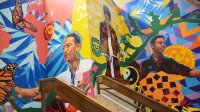4 Ways to Plan for the Success of Newcomer ELLs
To help newly arrived English language learners feel welcome, teachers can represent their cultures and languages in the classroom.
Your content has been saved!
Go to My Saved Content.Nearly one out of four K–12 students in the United States is an immigrant or the child of immigrants, and many such students are English language learners (ELLs). ELLs have a 68 percent high school completion rate nationwide, significantly lower than the national average for all students (85 percent). Making schools welcoming sites for ELL students where they can learn and thrive, and where their families can engage, is key to ensuring educational access and success.
Some teachers are innovating by making classrooms inclusive and offering spaces representative of the different cultural and linguistic backgrounds of students, and some schools are creating multilingual access points and events for families. Take, for example, the dozens of flags hanging from the ceiling of the cafeteria at Oakland International High School, where the student body hails from more than 35 countries, or the colorful mural (above) featuring images of people from all over the globe at Wellstone International High School in Minneapolis.
There are many ways that educators and schools can foster a sense of belonging and contribute to the educational success of immigrant and refugee students, many of whom are ELLs.
Welcoming All Newcomers
In this post, I share a few ideas that are detailed further in the forthcoming book Humanizing Education for Immigrant and Refugee Youth: 20 Strategies for the Classroom and Beyond, which I coauthored with educators and researchers Daniel Walsh, Lesley Bartlett, and Gabriela Martínez. In each of the four areas below, there are concrete suggestions to support newcomer and immigrant-origin students.
1. Understand who your students are. Successful educators know their students well and can track their progress. Many schools have a beginning-of-the year interview one-on-one with each student or when a student enters their school for the first time (see, for example, this intake form on page 20 of this report).
Other teachers keep a notebook or an online document to record the information they learn about students throughout the year from interactions with students and their families at school, on home visits, and so on, that can help the teachers understand the students’ needs and backgrounds.
2. Make students feel welcome. Many schools have multilingual approaches to offering a “warm embrace” to newcomer students and families, such as offering translations of materials or having parent ambassadors or liaisons from similar language backgrounds who establish a connection with families to share information about schedules, routines, expectations, etc. (see page 142 of this Newcomer Tool Kit from the U.S. Department of Education for an example of a Parent Ambassadors program from Tennessee).
Bulletin boards with words of welcome in many languages and international nights that allow families to share cultural traditions (through food, music, dance, etc.) encourage participation in a new context for newcomers and their families.
3. Take a trauma-informed approach. Many students have seen and experienced unspeakable violence that spurred their migration or during their journey to the U.S., and sometimes even once here. Having school staff who are attentive to students’ holistic well-being and give students opportunities to share, without pressuring them to, is of utmost importance.
School psychologists, interns from local community welfare agencies, or a school Wellness Center can encourage educators and students to attend to the social and emotional aspects of student well-being. This video by Colorín Colorado offers a glimpse into how one school in Michigan does this intentionally and effectively.
4. Engage families. Successful family engagement strategies include home visits (if families are comfortable), regular communication in home languages, and community walks (here’s a video about how one school’s annual walks allow students and parents to serve as the educators for a day, with school staff learning about their cultures and communities).
Teachers can create a WhatsApp thread with families’ mobile numbers to share announcements or information and facilitate communication (ideally, with translations if needed). Family corners or bulletin boards at the school can also facilitate a two-way flow of information between school and home.
Colocating services, such as mobile food banks coming to school once a month, as with Rudsdale Newcomer High School in California, or local nonprofits or universities holding workshops on campus on legal issues for families, make the school a hub for resources, information, and connection.
Ensuring that students and families are safe at school from immigration enforcement—in line with the 1982 Supreme Court ruling Plyler v. Doe, which guarantees that all children, whether they’re citizens or not, have the right to access educational services—is a prerequisite for building trust with families.
There are many ways that schools can foster inclusion, belonging, and success of newcomer students through classroom and whole-school approaches alongside strategies for English language learning. There is more information in my new coauthored book and its open-access companion website, which has links to numerous resources to support newcomer students.
Families invest their time and energy in school as a pathway to a better future; as educators, it is our duty to ensure that students have every opportunity to learn, thrive, and succeed.
